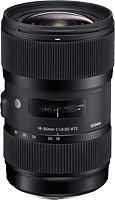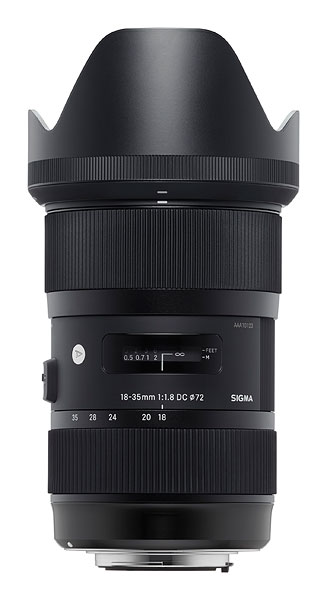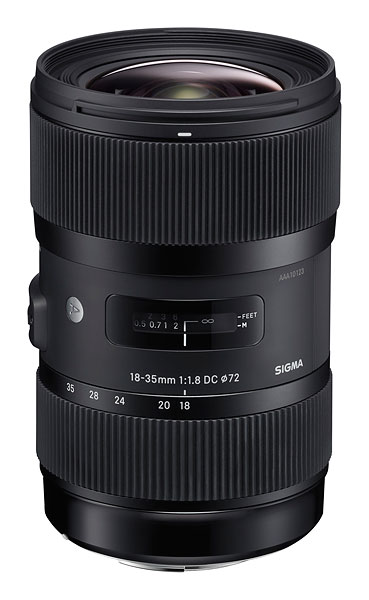Sigma: World’s first f/1.8 constant aperture zoom for Canon, Nikon, Sigma APS-C DSLRs
posted Thursday, April 18, 2013 at 5:10 AM EDT

Over the last couple of decades, third-party lens manufacturer Sigma Corp. has built a solid reputation for creating high-quality, enthusiast-friendly optics. Unlike almost all of its competitors, Sigma still manufactures all of its products in Japan, which in itself sets the company apart. Nevertheless, Sigma still actively seeks out other ways in which it can differentiate itself, with industry firsts such as user-customizable lens algorithms and a brand-new lens testing system that aims to minimize sample variation. A brand-new lens announced by the company today really reinforces just how far it has progressed in that goal.
The brand-new Sigma 18-35mm F1.8 DC HSM Art lens couldn't be much further from the kit lenses that made up the bulk of Sigma's production in the late 80s, and it captures another world's first for the company. From a glance at its name, you may be wondering if we've fallen victim to a typo, but we haven't. This really is a constant aperture, f/1.8 zoom lens! We've seen something close before -- Olympus offers a couple of Four Thirds-mount zooms with an f/2.0 constant-aperture, for example -- but only for a rather smaller image circle. Sigma's 18-35mm F1.8 is the brightest constant-aperture zoom we're aware of for an APS-C image circle, by some margin.
Admittedly, the new optic has a relatively abbreviated 2x zoom range, but that covers everything from approximately 27 to 53mm-equivalents on a typical camera with an APS-C -- or DX format, for Nikon fans -- image sensor. (And do take note, this is a cropped-sensor lens; the image circle won't allow for 35mm full-frame coverage.) There's a lot you can do within that range, and Sigma itself suggests that the lens will be particularly attractive for landscape, portrait, still-life, studio, close-up and casual photography. It hints at that usage by gifting the lens with its Art-series designation.

Of course, Sigma is bound to the same laws of physics as everybody else, and creating a lens like this does involve compromise. Not surprisingly, it's a fairly bulky optic: It's both heavier and longer than other equally wide (but less bright) constant-aperture, APS-C zooms such as the Nikon AF-S DX Zoom-Nikkor 17-55mm f/2.8G IF-ED, smc Pentax DA* 16-50mm F2.8 ED AL (IF) SDM, or Canon EF-S 17-55mm f/2.8 IS USM. (And despite its smaller, lighter body, that last lens is also image stabilized -- unlike the Sigma, Nikon, and Pentax models.)
If you're looking for the brightest lens and the shallowest depth of field, though, there's a big difference between a constant-aperture f/2.8 like those lenses, and a constant-aperture f/1.8 as in the new Sigma. The tradeoff in zoom range, size, and weight will likely prove more than worthwhile.
The Sigma 18-35mm F1.8 DC HSM Art lens will, we understand, be available in Canon EF and Nikon F lens mounts, as well as Sigma's own SA mount. It has an internal focusing / zooming design and an optical formula comprising 17 lens elements in 12 groups, including both Special Low Dispersion and aspheric elements, a Super Multi-Layer Coating, and a nine-bladed, rounded aperture diaphragm. The internal lens barrel, meanwhile, features Sigma's Thermally Stable Composite in its construction, said to have 25% higher elasticity than polycarbonate, and low thermal shrinkage. The minimum aperture available across the zoom range is f/16, and the minimum focusing distance is 11 inches for a 1:4.3 magnification.

Autofocus is catered for courtesy of Sigma's Hyper Sonic Motor drive, and the 18-35mm F1.8 lens features an improved AF/MF switch. The lens accepts 72mm threaded filters which do not rotate as the lens is adjusted, and has dimensions of 3.1 inches diameter and 4.8 inches length, with a weight of 28.6 ounces. A petal-type lens hood is included in the product bundle.
There are still a couple of important details we don't yet know: Sigma has yet to disclose information on pricing or availability for its new optic. Watch this space for details as soon as more information becomes available!